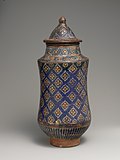Fritware, also known as stone-paste, is a type of pottery in which frit (ground glass) is added to clay to reduce its fusion temperature. The mixture may...
14 KB (1,711 words) - 09:46, 17 September 2024
Iznik pottery (section Fritware)
craftsmen in the town began to manufacture high quality pottery with a fritware body painted with cobalt blue under a colourless transparent lead glaze...
54 KB (6,906 words) - 04:54, 21 October 2024
Lajvardina-type ceramics (section Fritware)
causal. Lajvardina ceramics were usually made from a material known as fritware or stone paste. This is made by combining clay with crushed quartz fragments...
14 KB (1,546 words) - 08:20, 17 February 2023
years from 1150 saw great developments in Iranian ceramics. Firstly the fritware body and the glazes used on it were greatly improved, which allowed thinner...
32 KB (4,222 words) - 20:08, 20 August 2024
to around the 8th century. Another contribution was the development of fritware, originating from 9th-century Iraq. Other centers for innovative ceramic...
167 KB (18,900 words) - 23:12, 3 November 2024
Kashan, Iran, late 12th–13th century mina’i-fritware bowl. The scene in this bowl can be understood as depicting the enthroned (Second) Sulaymān with messengers...
83 KB (9,572 words) - 19:02, 5 November 2024
utilitarian vessels were made. It is similar to later Islamic stonepaste (or "fritware") from the Middle East, although that generally includes more clay. Egyptian...
40 KB (4,559 words) - 10:12, 27 September 2024
immediately visually apparent, but this is not always the case; for example fritware uses no or little clay, so falls outside these groups. Historic pottery...
93 KB (11,658 words) - 15:17, 5 November 2024
Ghiyath ad-Din Mesud II (fourth time) 1303–1307 Shatranj chess set, glazed fritware, 12th-century Iran. New York Metropolitan Museum of Art. Seljuk sarcophagus...
16 KB (2,136 words) - 09:12, 6 November 2024
pottery, historic production in the Islamic world was all in earthenware or fritware, the latter having some of the properties of hard-paste porcelain. Europeans...
7 KB (770 words) - 07:51, 30 March 2024
Iranian shatranj set, glazed fritware, 12th century Nishapur (New York Metropolitan Museum of Art)...
27 KB (3,039 words) - 00:13, 24 October 2024
stone materials in the 4th millennium BC, and Ancient Egyptian faience (fritware rather than a clay-based material) was self-glazing, as the material naturally...
24 KB (2,863 words) - 06:02, 3 October 2024
a bridge mill is from Córdoba, Spain in the 12th century. 13th century Fritware: It refers to a type of pottery which was first developed in the Near East...
81 KB (9,274 words) - 10:04, 2 November 2024
Kashan, Iran, late 12th–13th century mina’i-fritware bowl. The scene in this bowl depicts the enthroned (Second) Sulaymān with messengers and advisors...
24 KB (2,952 words) - 03:54, 22 October 2024
established, and Islamic attempts to imitate Chinese porcelain in their own fritware bodies had begun in the 12th century. These were less successful than those...
29 KB (3,614 words) - 09:58, 3 November 2024
or lime. What distinguishes Islamic ceramic mediums, called stonepaste, fritware, or siliceous ware, is that the bonding material is sourced from a liquified...
15 KB (1,671 words) - 18:40, 20 October 2024
Chess set (Shatrang); Gaming pieces. 12th century, Nishapur glazed fritware...
88 KB (8,149 words) - 18:05, 3 November 2024
and vases. Other pottery on display included fritware dishes from Syria and a set of twelve fritware bowls made in 1860, each inscribed in Arabic with...
34 KB (3,412 words) - 10:59, 9 August 2024
British Museum, gave its name to a category of similar blue and white fritware pottery known as 'Abraham of Kütahya ware'. It has an inscription in Armenian...
25 KB (2,249 words) - 22:32, 1 November 2024
manufacture of vessels, not out of clay, but out of a silicon paste ("fritware"), while metalworkers began to encrust bronze with precious metals. Across...
88 KB (11,356 words) - 09:57, 3 November 2024
Islamic lands during the medieval period". The ceramic body of white-ish fritware or stonepaste is fully decorated with detailed paintings using several...
25 KB (2,927 words) - 19:44, 5 November 2024
origin for Kubachi ware. Kubachi ware is made of stonepaste (also known as fritware). The decoration varies; some have turquoise glazes with black figures...
5 KB (468 words) - 17:11, 26 July 2024
area. It was, however, a centre for the production of highly decorated fritware vessels and what are known as İznik tiles during the 16th and 17th centuries...
21 KB (2,111 words) - 22:29, 26 October 2024
the city of İznik was growing and began producing a new "blue-and-white" fritware which adapted and incorporated Chinese motifs in its decoration. The most...
101 KB (12,224 words) - 03:27, 2 November 2024
of Iran's deep artistic heritage. Iranian chess (shatranj) set, glazed fritware, 12th century Nishapur. New York Metropolitan Museum of Art. Craftsmanship...
75 KB (9,044 words) - 18:35, 4 November 2024
Turkish (Ottoman) Carpets Gul Kilim Motifs Persian Turkish Prayer Pottery Fritware Hispano-Moresque Iznik Lustreware Mina'i ware Persian Chinese influence...
4 KB (464 words) - 18:03, 15 October 2024
that would check the king if the king moves. Iranian shatranj set, glazed fritware, 12th century, New York Metropolitan Museum of Art Persian manuscript from...
88 KB (10,014 words) - 08:26, 21 October 2024
Haft Awrang by Jami. Safavid period, 1556-1565 Monochrome ceramic bottle. Fritware painted under glaze. Safavid Iran, 17th century Washington manuscript I...
41 KB (3,969 words) - 21:05, 30 September 2024
Common uses include as components of a glaze or enamel, or for the body of fritware, when it usually mixed with larger quantities of quartz sand. (W) Fusion...
36 KB (4,507 words) - 18:32, 16 May 2024



























